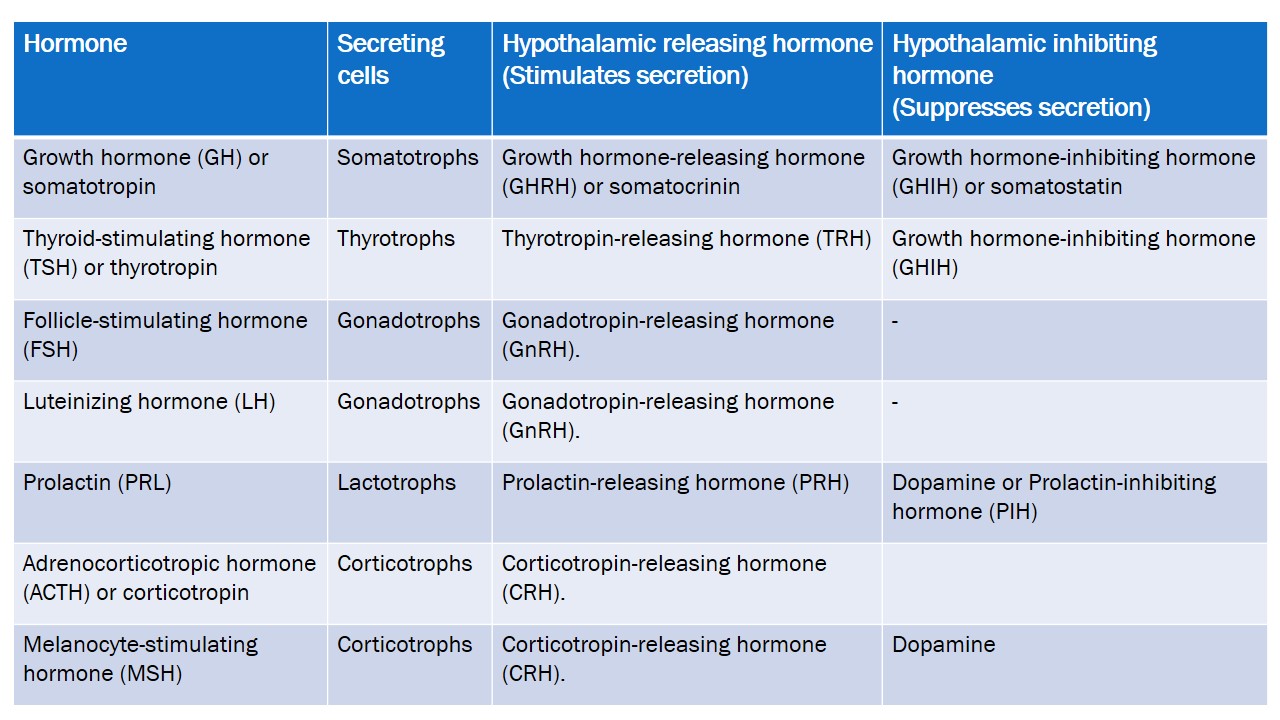Endocrine System: Hypothalamus and Pituitary Gland
If you want to read about the introduction of the endocrine system, follow the link
http://dpsru.blogspot.com/2021/07/endocrine-system-introduction.html
Hypothalamus and Pituitary Gland
The hypothalamus, a small area below the thalamus, is the master gland and is a major link between nervous and endocrine systems.
Cells in the hypothalamus produce at least nine different hormones.
The pituitary gland is a pea-shaped structure having a diameter of 1–1.5 cm and is located in the hypophyseal fossa of the sella turcica of the sphenoid bone.
The pituitary gland is attached to the hypothalamus through a stalk called the infundibulum.
The pituitary gland has two separate lobes called
- Anterior pituitary (adenohypophysis)
- Posterior pituitary (neurohypophysis)
The anterior pituitary constitutes the 75% weight of the pituitary gland and is made up of epithelial tissue. The anterior pituitary has two parts in adults:
- The pars distalis is the larger portion.
- The pars tuberalis forms a sheath around the infundibulum.
The posterior pituitary is consists of neural tissue. It also consists of two parts:
- The pars nervosa is the larger bulbar portion.
- The infundibulum.
The pars intermedia is the third region of the pituitary gland and it gets reduced (atrophied) during human fetal development and no longer exists as a separate lobe in adults. Some of the cells of the pars intermedia migrate to the anterior pituitary.
The pituitary gland secretes seven hormones.
Together, the hormones of the hypothalamus and pituitary gland regulate virtually all aspects of growth, development, metabolism, and homeostasis.
Hypophyseal Portal System
Hypothalamic hormones (stimulatory or inhibitory) reach the anterior pituitary through a portal system (Fig. 1).
 |
| Fig. 1: Hypophyseal Portal system |
In a portal system, blood flows from one capillary network to the second capillary network via a portal vein before returning to the heart.
In the hypophyseal portal system, blood from capillaries in the hypothalamus reaches to capillaries of the anterior pituitary. This portal system transports the hypothalamic hormones to the anterior pituitary before sending them into the general circulation.
Anterior Pituitary Cells and Their Hormones
Five types of anterior pituitary cells—somatotrophs, thyrotrophs, gonadotrophs, lactotrophs, and corticotrophs—secrete seven hormones (Table 1).
Table 1: Hormones and Cells of the Anterior Pituitary.
Table 2: Summary of the Principal Actions of Anterior Pituitary Hormones.
Control of Anterior Pituitary Secretion
- Neurosecretory cells of the hypothalamus synthesize the hypothalamic releasing and inhibiting hormones in their cell bodies and package the hormones inside vesicles.
- Upon excitation, the neurosecretory cells release the hormones that diffuse into the blood of the primary plexus of the hypophyseal portal system.
- The hypothalamic hormones reach the secondary plexus via blood and interact with the cells of the anterior pituitary. Under the influence of the hypothalamic hormones, the anterior pituitary cells secrete hormone into the capillaries of the secondary plexus.
- The anterior pituitary hormones enter into general circulation via the hypophyseal veins to reach their target cells. Those hormones that act on other endocrine glands are named tropic hormones or tropins.
Posterior Pituitary
Control of Posterior Pituitary Secretion
- Neurosecretory cells of the hypothalamus synthesize oxytocin and antidiuretic hormone (ADH). The hormones are then packaged into vesicles.
- The vesicles reach the axon terminal located in the posterior pituitary to get stored.
- Upon stimulation, neurosecretory cells of the hypothalamus release the hormones (oxytocin or ADH) into the capillary plexus of the infundibular process.
- The released oxytocin or ADH moves into general circulation via the hypophyseal vein to reach their target tissues in the body.








Comments
Post a Comment